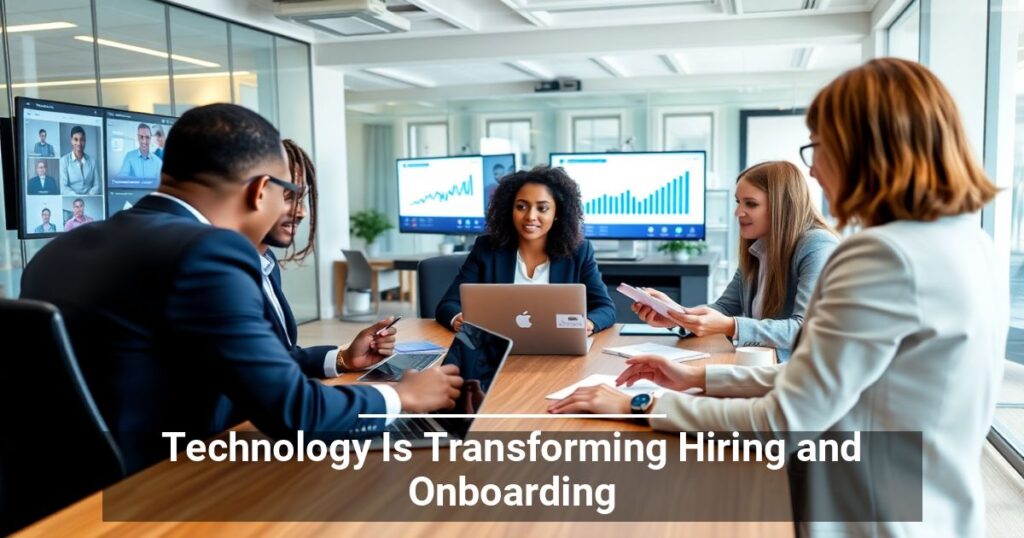
People are the lifeblood of any company, and your company’s approach to hiring and onboarding has the potential to make or break anyone’s experience. Cumbersome application and interviewing processes, mountains of paperwork, and confusing policies and training can cause new hires to consider leaving before their first day of “real” work.
How you bring new people into your company sets the tone for their experience. Implementing technological solutions to streamline the process saves time, making it more efficient, effective, and pleasant for everyone.
Digital HR Platforms for Better Hiring
When you need to hire new team members, time is of the essence — and job seekers don’t want to deal with drawn-out hiring processes, either. Technology enables employers and candidates to achieve fast and efficient hiring processes.
Companies have long used Human Resources Information Systems (HRIS) and Applicant Tracking Systems (ATS) to simplify hiring processes. An ATS can easily narrow the pool of candidates to those with the best experience match. Although humans make hiring decisions, technology helps reduce information overload and automate critical tasks.
The emergence of AI-driven recruitment and hiring is transforming these tools, equipping them with features such as predictive hiring analytics. These tools provide insights that enable faster hiring and onboarding processes without compromising quality.
AI also enables HR to verify the accuracy of candidate data. AI tools for identity verification create a better experience for potential employees while ensuring they are who they claim to be.
Why Onboarding Matters More Than You Might Think
AI-driven recruitment helps you find and hire great people, but how you take care of them after they accept the offer sets them up to feel welcomed and ready to contribute. Your onboarding process makes the critical first impression for your entire company. Technology helps you do it right.
It wasn’t that long ago that onboarding meant thick packets of paperwork, lengthy meetings, and back-and-forth emails. Now, companies use digital tools to automate and organize the entire process. These might include:
- Automated onboarding systems that allow new hires to complete tax forms, benefits information, and direct deposit details before day one.
- Employee onboarding software that walks employees through every step, from submitting identification documents to scheduling training.
- Digital training modules that replace endless in-person sessions with interactive content that employees can learn at their own pace.
- Built-in reminders and tracking to ensure people stay on track, sending reminders to submit information or complete tasks when needed.
This all adds up to the ability of your HR team to spend less time on logistics and more time focusing on people. However, effective hiring and onboarding also directly benefit your bottom line. A smooth start builds employee confidence and engagement from day one. When the HR team spends less time on administration, they can focus on long-term goals and people-focused initiatives.
Use Technology To Give Everyone a Better Experience
Hiring and onboarding aren’t just processes. They inform new employees about the kind of company they’ve joined. By implementing a virtual hiring process and utilizing technology to streamline onboarding, you’re sending the right message from the start — that’s something worth investing in.
Recent Posts
Eliminate All IT Worries Today!
Do you feel unsafe with your current security system? Are you spending way too much money on business technology? Set up a free 10-minute call today to discuss solutions for your business.

Could having cyber insurance make your establishment a bigger target for hackers? It’s a reality many companies are starting to confront. Keep reading to learn more.
The New “Treasure Map” for Threat Actors
Hide and encrypt the details of your cyber liability policies at all costs. New research suggests that ransomware operators often make steeper demands once they discover their target has this type of insurance.
Tom Meurs, a member of the Dutch police, made this discovery while researching his Ph.D. dissertation. He analyzed 454 ransomware attacks between 2019 and 2021 and started noticing a pattern. The first thing threat actors do after successfully breaching their target environment is hunt for evidence of a cyber-insurance policy.
Expect the ransom demand to spike if they find it, often by a factor of 2.8x or as high as 5.5x if they also manage to steal important data.
The Cost of Cyber-Insurance Details Falling Into the Wrong Hands
Meurs determined that insured companies end up paying $800,000 on average 44% of the time, while non-insured companies only pay around $150,000 24% of the time.
The researcher also mentions that threat actors specifically target establishments from high-paying sectors. For example, the ICT sector tends to take a bigger hit because it often supplies its technology to others, which means multiple companies may become victims of the same attack by association.
Why You Should Never Engage With Ransomware Actors
These unfortunate findings align with what cybersecurity researchers have observed for years. Criminals try to coerce their victims by arguing that since they have cyber insurance and data breach coverage, they have nothing to lose.
But is that true? Law enforcement and ransomware protection specialists advise against paying ransoms for the following reasons:
You’re Not Guaranteed a Positive Outcome
Paying doesn’t promise results. Even if you send the money, attackers may not release your data or send a decryption key that doesn’t work. Some files might stay locked or become damaged.
Acquiescing also encourages more attacks and fuels their operations.
It May Violate Your Insurance Policy
Check the fine print of your policy. It may have terms that expressly prohibit sharing information or directly contacting the attacker.
If the criminal is part of a sanctions list, you could face legal consequences, too. Familiarize yourself with relevant government guidance on this issue, including:
- November 8, 2021, FinCEN Advisory
- September 21, 2021, Updated OFAC Ransomware Advisory
It’s Not the Most Effective Way To Restore Operations
Even if you pay the ransom, there’s no guarantee everything will return to normal. Decryption tools may work slowly or fail to fully recover your data. Focus on backups and a robust, well-rehearsed incident response plan to regain control efficiently.
It Could Impact Future Premiums
The insurer isn’t necessarily the only losing party. Payment of a “limits loss” impacts future premiums differently than a partial loss. Ask your provider for more details on premium calculation.
Taking the Proactive Route for Your Businesses
Why wait for threat actors to target you? Cyber insurance helps cover financial risks, but prevention is key. Invest in cybersecurity training for employees, risk assessment tools, and backup systems.
Recent Posts
Eliminate All IT Worries Today!
Do you feel unsafe with your current security system? Are you spending way too much money on business technology? Set up a free 10-minute call today to discuss solutions for your business.
